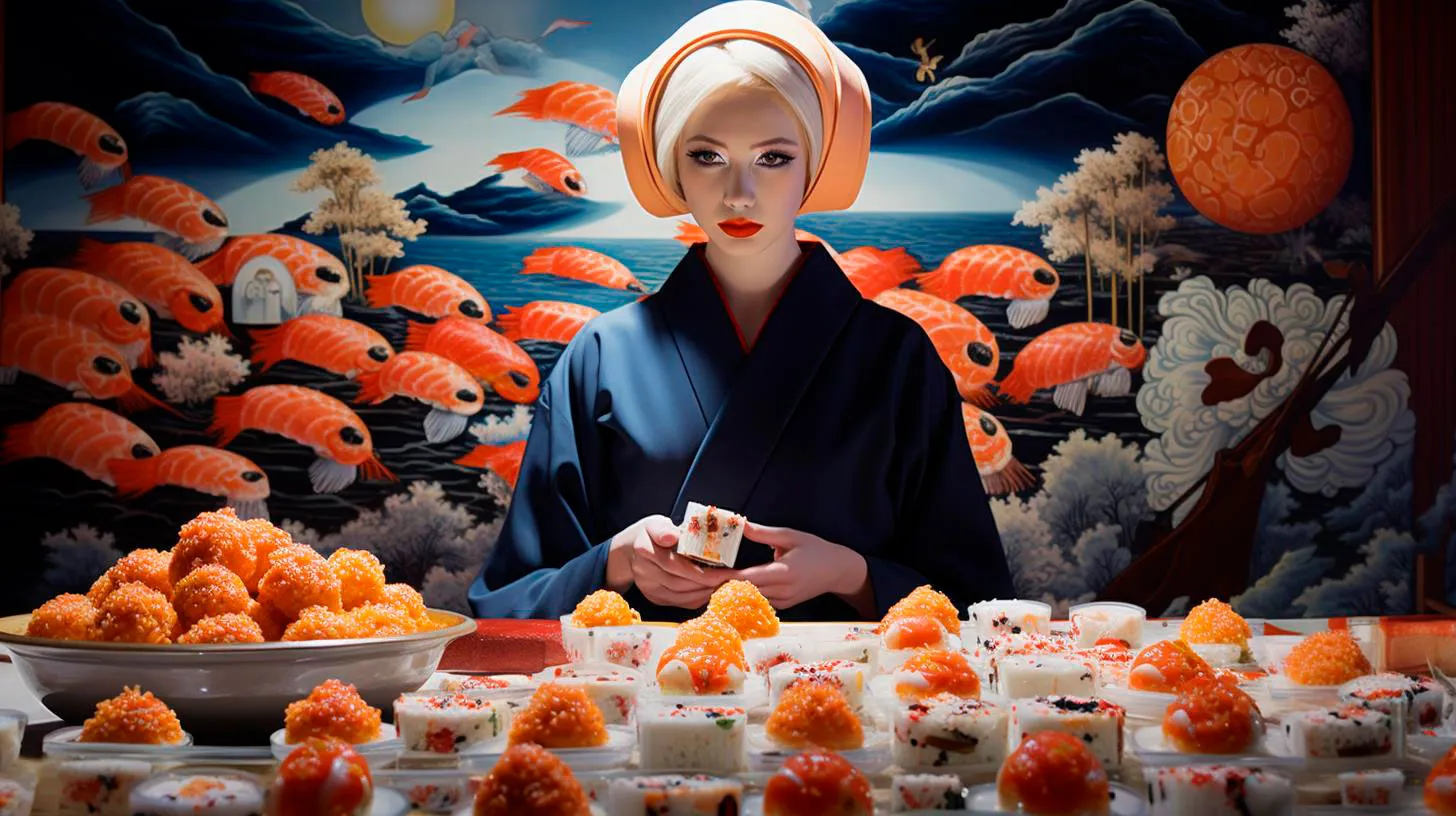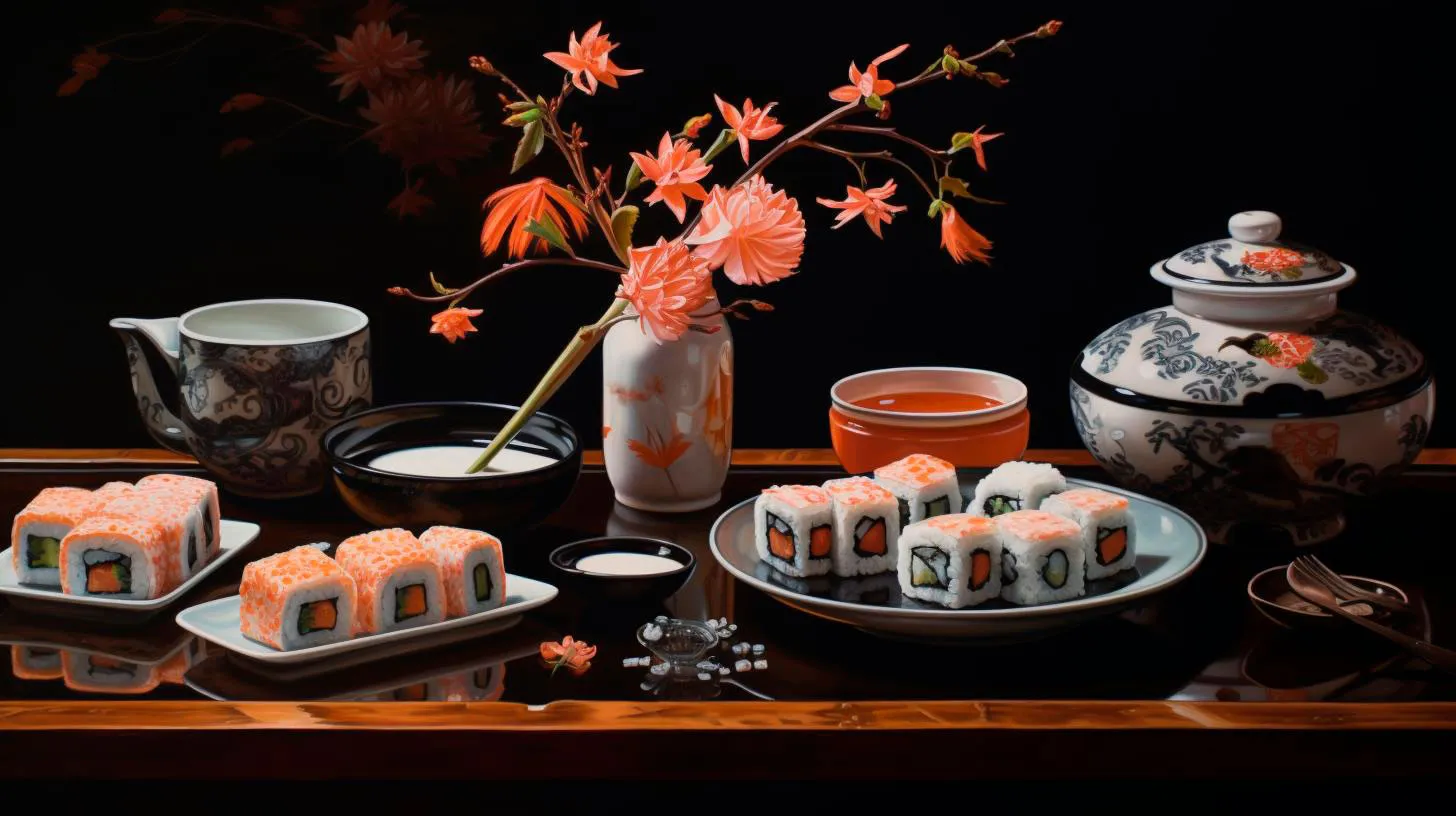Exploring the Tasty Rivalry: Japanese Sushi vs American Sushi
Japanese Sushi: Tradition at Its Finest
Japanese sushi is deeply rooted in tradition and has been perfected over centuries. It is characterized by its commitment to freshness, simplicity, and attention to detail. Here are some key features of Japanese sushi:
- Quality ingredients: Japanese sushi emphasizes the use of the highest quality fish and seafood. The fish used are often caught locally and prepared with minimal seasoning to showcase their natural flavors.
- Technique: Japanese sushi chefs undergo years of rigorous training to master their craft. They have exceptional knife skills and possess the ability to create aesthetically pleasing sushi pieces that are both visually appealing and delicious.
- Variety: Japan boasts a wide array of sushi styles, from nigiri (a slice of fish placed on a small mound of rice) to maki (rolled sushi with various fillings). Each style offers a unique experience, showcasing the diversity of flavors and textures.
Japanese sushi has gained international acclaim for its dedication to tradition and artistry. It is an experience that goes beyond just satisfying your hunger, making it a must-try for sushi enthusiasts.
American Sushi: Innovation and Fusion
American sushi, on the other hand, has its own distinctive characteristics that have evolved to suit the local palate. While it maintains some of the traditional elements of Japanese sushi, it also incorporates innovative techniques and ingredients. Here are some key features of American sushi:
- Flavor experimentation: American sushi incorporates a wide range of flavors, sometimes straying from traditional sushi norms. Elements like spicy mayo, cream cheese, and unique sauces enhance the taste and add a sense of adventure to the dining experience.
- Vegetarian and vegan options: As dietary preferences have evolved, so has sushi. American sushi offers an abundance of vegetarian and vegan options, making it more inclusive and appealing to a broader audience.
- Ingredient fusion: American sushi ventures beyond traditional Japanese ingredients, incorporating diverse elements like avocado, mango, and even items like fried chicken or bacon to create sushi rolls with unexpected and exciting flavors.
American sushi has gained popularity as it caters to a wider range of taste preferences and dietary needs. It embraces creativity and offers a fusion of flavors that can be a delightful departure from traditional sushi for those seeking a unique dining experience.
The Rivalry: Which Sushi Reigns Supreme?
The debate over which sushi style is superior, Japanese or American, continues to spark discussions among sushi lovers. However, it’s important to note that both styles have their own merits and should be celebrated for their distinctiveness.
Key Takeaways:
- Japanese sushi is known for its commitment to tradition, quality ingredients, and meticulous preparation techniques.
- American sushi embraces innovation, experimentation, and ingredient fusion, catering to a wider range of tastes and dietary preferences.
- Both Japanese and American sushi offer unique and delightful dining experiences, and the choice ultimately depends on personal preference.
- Trying both styles allows you to appreciate the nuances and appreciate the evolution of sushi as a global culinary delight.
Statistically speaking, the sushi industry has witnessed remarkable growth in recent years. According to a report by Statista, the global sushi market is projected to reach approximately $22.7 billion by 2024. This growth is a testament to the enduring popularity of sushi among food lovers worldwide.
Whether you choose to indulge in the refined and traditional Japanese sushi or embark on a flavorful adventure with American sushi, one thing is for certain – both styles offer a sensory and culinary experience that is undeniably delicious. So, go ahead and explore the intriguing rivalry between Japanese sushi and American sushi, and let your taste buds be the ultimate judge!
Social Sushi: The Cultural Phenomenon of Japanese Sushi
In this article, we delve into the world of sushi, exploring its history, cultural significance, and its ever-growing popularity.
A Bite into History
The origins of sushi can be traced back to ancient times in Southeast Asia, where the technique of preserving fish in fermented rice was first developed as a method of food preservation. This method eventually made its way to Japan in the ninth century, where it evolved into the sushi we know today. Initially, sushi was primarily a street food, sold by food vendors who prepared it as a quick and convenient meal for the working class.
- Traditional Japanese sushi rice is seasoned with vinegar, sugar, and salt. This gives it a distinct tangy flavor that complements the fresh ingredients used.
- Nigiri sushi, the most well-known sushi style, consists of a small mound of rice topped with a slice of raw or cooked fish.
- Sashimi is another popular sushi variation, which comprises thinly sliced raw fish or seafood served without rice.
- Maki sushi, commonly known as sushi rolls, is made by rolling rice, fish, and vegetables in a sheet of nori (seaweed).
A Cultural Icon
Sushi’s popularity has transcended borders, becoming an emblem of Japanese culture. With its elegant preparation, sushi has been closely associated with precision, attention to detail, and aesthetic beauty. Japanese sushi chefs undergo years of rigorous training to master the art of sushi-making, ensuring a remarkable dining experience for patrons.
- The traditional sushi bar, known as an “Edomae-style” sushi bar, symbolizes intimacy between the chef and the customer. The chef prepares each piece of sushi right in front of the diner, customizing flavors and textures according to their preferences.
- Sushi etiquette is highly respected in Japan, emphasizing the importance of eating sushi with your hands and not using chopsticks. This intimate connection between the food and the diner is believed to enhance the overall sensory experience.
- Sushi has also influenced various aspects of popular culture, from movies and television shows to fashion and art. The concept and aesthetics of sushi have left a lasting impression on creative industries worldwide.
The Sushi Boom
Sushi has gone through a remarkable global transformation, evolving from a niche delicacy to a mainstream culinary trend. Thanks to globalization and the advent of new cooking techniques, sushi has become more accessible and enjoyed by people from all walks of life. According to recent research, sushi has become a $20 billion industry worldwide, with no signs of slowing down.
- Sushi’s appeal as a healthy and nutritious food choice has contributed to its popularity. The use of fresh ingredients, such as fatty fish rich in omega-3 fatty acids, has attracted health-conscious eaters seeking a balanced diet.
- The rise of sushi popularity has led to the emergence of innovative sushi creations, catering to diverse tastes and dietary preferences. Variations like vegetarian sushi, fusion rolls, and customized toppings have expanded the options available in sushi restaurants.
- Social media has played a significant role in bolstering sushi’s popularity, with Instagram boasting over 15 million posts tagged with #sushi. The visually stunning presentation of sushi makes it an ideal subject for food photography and sharing gastronomic experiences online.
Conclusion
Sushi has undoubtedly become a global cultural phenomenon, captivating food lovers around the world with its rich history, unique dining experience, and remarkable flavors. As its popularity continues to soar, sushi remains a testament to Japan’s culinary heritage and an enticing gateway into exploring the diverse flavors of Japanese cuisine.
So next time you savor a piece of sushi or marvel at an intricately prepared sushi roll, remember that you’re not just enjoying a delicious meal – you’re immersing yourself in a cultural experience that has shaped the way we appreciate food.
A Taste Odyssey: Comparing the Delightful World of Japanese and American Sushi
In this article, we take a journey through the fascinating world of sushi variations, comparing the traditional Japanese sushi with its American counterpart to discover their unique flavors, techniques, and cultural significance.
Japanese Sushi: The Epitome of Elegance and Tradition
Japanese sushi, rooted in centuries of tradition, has become a global symbol of Japanese cuisine. Its exquisite flavors, careful presentation, and emphasis on quality ingredients make it a culinary art form. Here are some key elements of Japanese sushi:
- Ingredients: Japanese sushi primarily focuses on fresh seafood like tuna, salmon, and yellowtail. Other ingredients include rice, seaweed (nori), soy sauce, and wasabi.
- Types: Nigiri, made with a small hand-formed ball of rice topped with fish, and maki, consisting of rice and fillings rolled in nori, are two popular forms of Japanese sushi.
- Techniques: Sushi chefs in Japan undergo years of training to perfect their skills. The art of preparing sushi involves precise knife work, proper cooking of rice, and meticulous attention to detail.
- Presentation: Japanese sushi is known for its beautiful presentation. Each piece is carefully crafted to showcase the natural colors and textures of the ingredients.
Japanese sushi is a symbol of elegance and sophistication, offering a harmonious blend of flavors and textures. Now let’s explore the American take on this delectable dish.
American Sushi: Fusion and Innovation
Inspired by Japanese sushi, American chefs reimagined the dish to suit the evolving taste buds of a diverse population. American sushi embraces experimentation, fusion with other cuisines, and a greater emphasis on cooked ingredients. Here are some features that define American sushi:
- Ingredients: While American sushi still uses traditional ingredients like rice and nori, it incorporates a wider range of fillings, including cooked fish, vegetables, and even non-traditional items like cream cheese or avocado.
- Variety: American sushi offers an extensive menu with a variety of rolls, often named inventively. Some popular examples include the California roll (with avocado, crab, and cucumber) and the Philadelphia roll (with smoked salmon and cream cheese).
- Techniques: American sushi introduces new techniques like tempura frying, deep-frying whole rolls, and using unconventional sauces and dressings to enhance the flavors.
- Diversity: Due to the fusion of cultures and culinary influences, American sushi caters to a diverse range of tastes and dietary preferences, making it accessible to a wider audience.
American sushi reflects the spirit of innovation and experimentation, enticing customers with its unique combinations and flavors. Now, let’s summarize the key takeaways from this delightful journey.
Key Takeaways and Final Thoughts
1. Japanese sushi embodies elegance, tradition, and a strong emphasis on the finest seafood, while American sushi offers fusion, innovation, and a diverse range of ingredients.
2. Japanese sushi emphasizes the art of presentation and meticulous techniques, while American sushi focuses on variety and catering to diverse tastes.
3. Both Japanese and American sushi offer unique experiences and contribute to the popularization of this beloved dish around the world.
When it comes to sushi, the flavor and style you prefer ultimately depend on your personal taste and cultural background. Whether you crave the elegance of traditional Japanese sushi or the fusion of flavors in American sushi, both offer a delightful culinary journey. So, go ahead and explore the wonderful world of sushi, one delicious bite at a time!
Sushi Showdown: Unpacking the Differences between Japanese and American Sushi
In this article, we’ll take a deep dive into the world of sushi, exploring the variations between Japanese and American sushi. So, let’s roll!
1. The Rice
The foundation of any good sushi roll is the rice. In Japanese sushi, short-grain rice is used, which is stickier and has a slightly sweet taste. American sushi, on the other hand, often utilizes long-grain rice, which tends to be fluffier and less sticky. The difference in rice can significantly affect the texture and overall taste of the sushi.
2. Fillings and Toppings
When it comes to fillings and toppings, the variations between Japanese and American sushi are vast. In Japan, traditional sushi tends to focus on simple flavors, featuring ingredients like fresh fish, seafood, and pickled vegetables. American sushi, meanwhile, embraces creativity, combining a wide range of ingredients such as cream cheese, avocado, and even fruits like mango.
- Japanese Sushi: Classic options include tuna, salmon, shrimp, and traditional vegetables.
- American Sushi: Popular choices include the California roll with crab meat, avocado, and cucumber, and the dynamite roll with spicy mayo and tempura shrimp.
3. Presentation and Size
The way sushi is presented differs significantly between Japan and the United States. In Japan, sushi is typically served in small, bite-sized pieces called nigiri or as rolls with simple garnishes. On the other hand, American sushi often features larger rolls with extravagant presentations. Additionally, American rolls tend to have more fillings, making them heartier and more substantial.
4. Serving Style
In Japan, sushi is often enjoyed as an art form and is served with minimal soy sauce and wasabi. The focus is on appreciating the flavors of the fish. In contrast, American sushi emphasizes customizable options. Sushi lovers in the U.S. enjoy adding soy sauce, wasabi, and pickled ginger according to their taste preferences. This variation allows for a more personalized experience.
Key Takeaways
- Japanese sushi uses short-grain rice, while American sushi is often made with long-grain rice.
- Japanese sushi highlights simple, traditional flavors, whereas American sushi combines various ingredients to create unique flavor profiles.
- Japanese sushi is presented in bite-sized portions, while American sushi tends to have larger rolls.
- Japanese sushi focuses on appreciating the natural flavors of the ingredients, while American sushi encourages customization.
In conclusion, both Japanese and American sushi have their own merits and distinct qualities. Japanese sushi emphasizes tradition, simplicity, and the purity of flavors, while American sushi embraces creativity, customization, and larger portions. The choice between the two ultimately depends on personal taste preferences and the desired dining experience. So, whether you lean towards the traditional or the contemporary, sushi is a culinary delight that celebrates the beauty of raw fish and the artistry of its preparation. Now it’s time to satisfy those sushi cravings!



